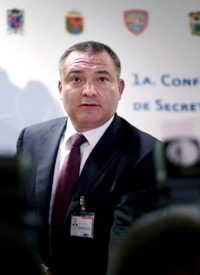
Four and one-half years of violent conflict between drug cartels and the government have brought unimaginable bloodshed to the people of Mexico, and now one of that nation’s most highly placed law enforcement officials is predicting that it may be as much as four more years before the violence will begin to subside.
Last week, Public Safety Secretary Genaro Garcia Luna (pictured) praised the “substantial” progress that Mexico has made since December 2006 when President Felipe Calderon came to power. But that does not mean that the years spent in armed conflict against the Mexican cartels is going to come to an end any time soon. Approximately 35,000 people have been murdered thus far in the conflict; in fact, as reported previously for The New American, the murder rate in Ciudad Juarez had increased by 40 percent in February 2011 over levels the previous year. Even more appallingly, an overwhelming majority of the criminals perpetrating these murders will remain unpunished by Mexico’s justice system; in fact, 98.5 percent of all violent crimesare never punished in a court of law.
However, Garcia Luna believes that the government is winning the conflict, and will continue to make progress—if the Mexican Congress accedes to Calderon’s changes to the nation’s police forces. As reported at BorderlandBeat.com:
In regard to ending the armed forces’ role in law enforcement, as demanded by domestic and international human rights organizations, the secretary said it would be possible to do so within three years of the Mexican Congress’ approving Calderon’s plan to overhaul and streamline the country’s myriad police forces.
Mexican states and municipalities must have adequate numbers of “trained” police to take over from the military the responsibility for public safety, Garcia Luna said.Calderon’s scheme calls for the country’s roughly 1,600 police departments to be consolidated into 32 agencies – one for each of the 31 states and the Federal District.
It must be noted that the secretary’s estimate was that it would be at least three to four years before the violence begins to subside; according to an interview he gave for Televisa, “In about seven years we will begin a downward trend in violence”.
The violent struggle between the government and the drug cartels has not been confined to the borders of Mexico; the cartels have been active in the United States as well as Guatemala and Honduras. A story from the Associated Press covering last week’s International Drug Enforcement Conference in Cancun provided some details of the spreading influence of the cartels:
Officials at the drug control conference say the Zetas have now spread their reign of terror from the border with the United States to the border with Guatemala — and across it.
Guatemala Security Vice Minister Mario Castaneda said the Zetas are recruiting former elite Guatemalan soldiers and training them in camps in the Central American country. …Guatemalan authorities are also investigating military personnel for allegedly stealing weapons from the army and selling them to drug traffickers, Castaneda said.
“We have documented at least three robberies” of army weapons, he said.In 2009, Guatemalan police seized 563 grenades and more than 3,800 bullets from the Zetas that investigators said belonged to the army.
Since 2008, when the Zetas killed Guatemalan drug boss Juan Jose “Juancho” Leon, the gang began controlling cocaine traffic in the area.Castaneda said Mexico’s powerful Sinaloa drug cartel is also in Guatemala. A U.S. law enforcement official who was not authorized to be quoted by name said that Sinaloa dominates trafficking in Costa Rica, Nicaragua and Panama and that the Gulf cartel also has operations in the first two countries.
Both the Zetas and Sinaloa cartels appear to operate in Honduras, and Sinaloa has made some inroads in Guatemala as well, the official said. The Central American countries are “a major route for the cocaine coming up from South America,” the official said.
Calderon has attempted to blame the citizens of the United States for the drug violence in his nation; speaking before a joint session of Congress last May, he blamed the “high demand for drugs” and “flow of high-powered weapons” across the border. However, since then it has been revealed that the Obama administration is, in fact, responsible for a significant proportion of the firearms which have flowed into Mexico as part of the “Fast and Furious” operation which involved the ATF instructing gun dealers to sell firearms to individuals they believed would, in turn, smuggle those arms into Mexico.
The Obama administration has actually made it easier for Mexican criminals to procure firearms, while at the same time failing to make a credible effort to reduce the rate of illegal border crossings between the U.S. and Mexico. Meanwhile, the Calderon government’s estimation of its ability to bring the violence to an end pushes any measurable progress at least several years into the future. With such appalling leadership at the helm, many citizens in both nations are wondering why they should place any confidence at all in the plans of politicians who promise success at some distant date as a justification for their present failures.
Photo: Mexico’s Public Safety Secretary Genaro Garcia Luna gestures after a press conference in Mexico City, Monday, Feb. 16, 2009.: AP Images



